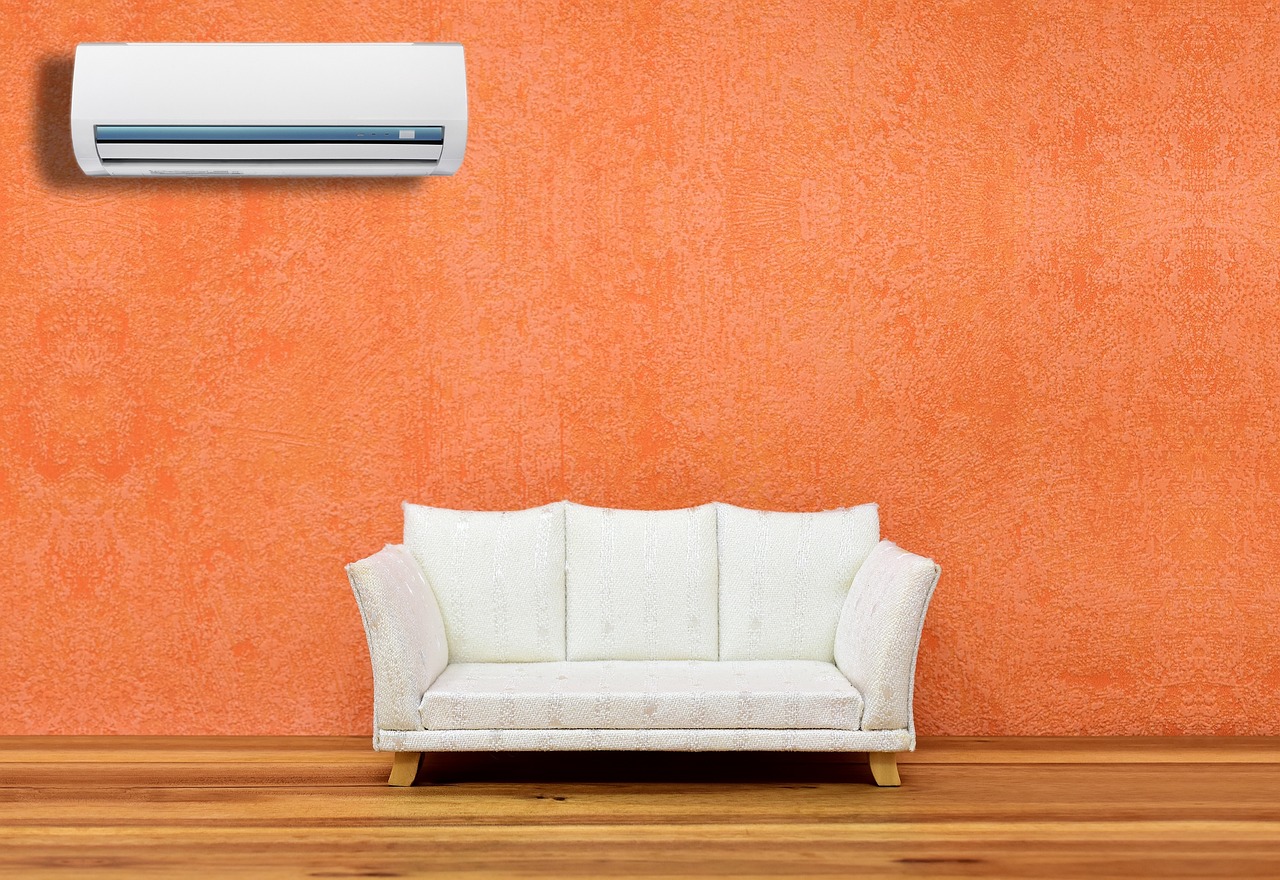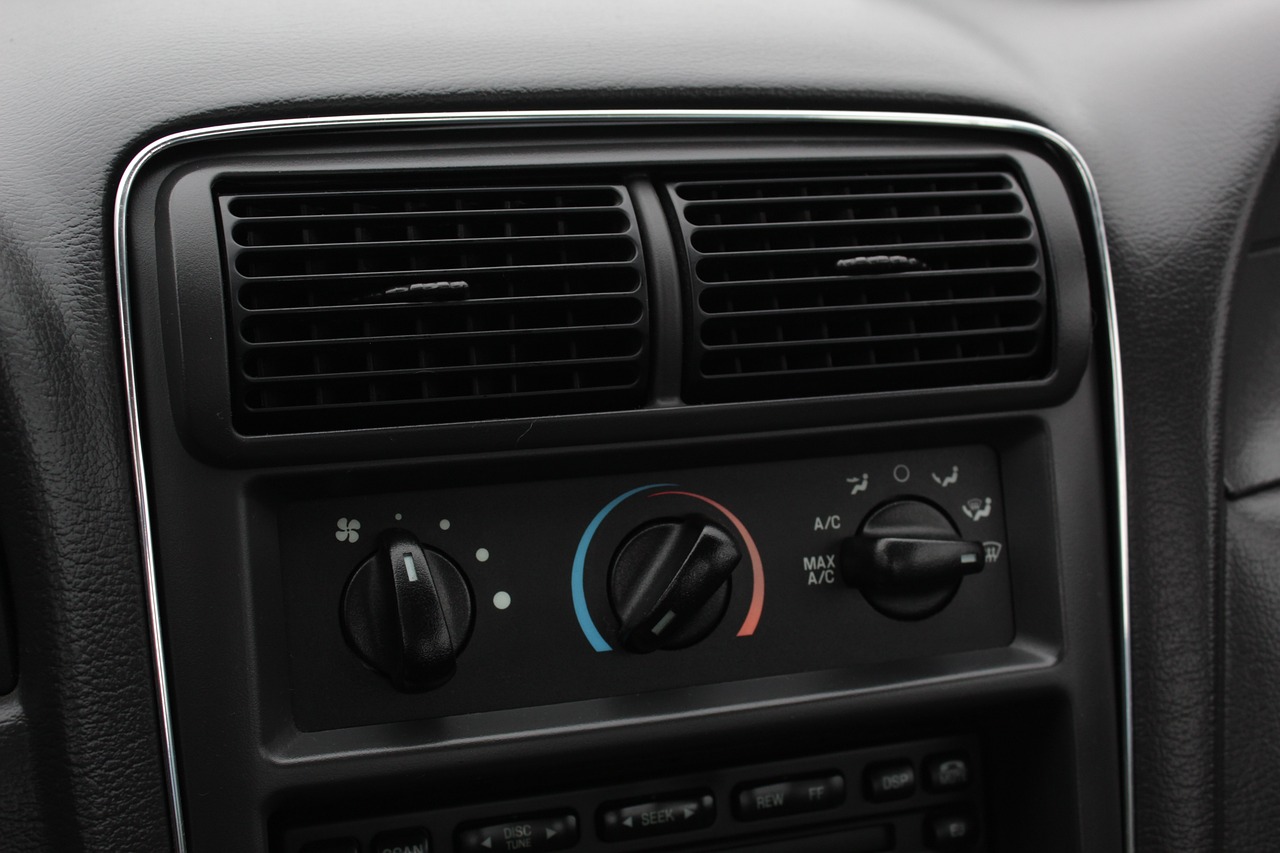Indoor Air Pollution: An Overlooked Environmental Hazard
Indoor air pollution is a **silent intruder** in our lives, often lurking unnoticed while we go about our daily routines. Most of us are aware of the dangers of outdoor pollution, but what about the air we breathe inside our homes and workplaces? It’s a topic that deserves more attention, as the air within our walls can be just as harmful—if not more so—than the air outside. This article dives into the **often-overlooked issue** of indoor air pollution, shedding light on its sources, health impacts, and practical solutions to enhance air quality.
So, what exactly is indoor air pollution? In simple terms, it refers to the presence of harmful pollutants in enclosed spaces. These pollutants can stem from a variety of sources, including household products, building materials, and even the activities we engage in daily. The significance of indoor air pollution cannot be understated; it can affect our health, comfort, and overall well-being. In fact, studies show that indoor air can be **up to five times more polluted** than outdoor air, making it crucial to understand what we are breathing in.
As we explore this topic, think about your own living space. Are there lingering odors from cleaning products? Do you notice dust accumulating in corners? These are not just minor annoyances—they can be indicators of poor air quality. By recognizing the sources of indoor air pollution and taking steps to mitigate them, we can create healthier environments for ourselves and our loved ones.
Indoor air pollution is a **complex issue** that can arise from various factors. It encompasses a wide range of pollutants, including gases, chemicals, and particulate matter that can have adverse effects on our health. The importance of addressing this issue lies in the fact that we spend approximately **90% of our time indoors**, making the quality of indoor air a critical aspect of our overall health. It’s time to take a closer look at what’s happening in our indoor environments and why it matters.
Everyday items in our homes contribute to indoor air pollution in ways we might not even realize. From the cleaning products we use to the materials in our furniture, these sources can release harmful substances into the air. Understanding these common sources is the first step toward reducing our exposure and improving indoor air quality.
One of the most prevalent offenders in indoor air pollution is **Volatile Organic Compounds (VOCs)**. These are organic chemicals that can easily evaporate at room temperature and are found in many household items. Common sources of VOCs include paints, varnishes, and even some cleaning products. Prolonged exposure to VOCs can lead to serious health risks, including headaches, dizziness, and respiratory issues. It’s essential to be aware of the products we use and their potential impact on our health.
Many cleaning agents on the market today contain VOCs that can adversely affect indoor air quality. For instance, products like air fresheners, disinfectants, and even laundry detergents can release harmful chemicals into the air. Instead of opting for conventional products, consider switching to **safer alternatives**. Look for cleaning products labeled as low-VOC or natural, which can help maintain a cleaner and healthier indoor environment without compromising your well-being.
When it comes to home renovations, paints and solvents are significant contributors to indoor air pollution. Many conventional paints emit VOCs, which can linger in the air long after the application. To minimize their impact, consider using **low-VOC or zero-VOC paints**. Not only do these options reduce harmful emissions, but they also come in a variety of colors and finishes that can beautify your space without the toxic side effects.
Particulate matter, often referred to as PM, can originate from various indoor activities such as cooking, smoking, and even using certain types of heating systems. This fine dust can penetrate deep into our lungs, leading to serious health issues over time. To combat particulate matter, ensure proper ventilation when cooking and consider using air purifiers that can effectively filter out these harmful particles.
The health impacts of indoor air pollution are profound and can lead to a range of issues. From short-term symptoms like headaches and fatigue to long-term consequences such as **respiratory diseases and cardiovascular problems**, the stakes are high. Understanding these health impacts is crucial for making informed choices about our indoor environments.
Indoor air pollutants can exacerbate existing respiratory conditions such as asthma and allergies. Vulnerable populations, including children and the elderly, are particularly at risk. Poor air quality can trigger asthma attacks, leading to increased hospital visits and a decline in overall health. By addressing indoor air pollution, we can help alleviate these issues and promote better respiratory health for everyone.
Chronic exposure to indoor air pollution can lead to serious long-term health problems, including cardiovascular diseases and even cancer. Studies have shown that individuals who are regularly exposed to poor indoor air quality are at a higher risk for these conditions. It’s essential to take proactive steps to reduce exposure to indoor pollutants and protect our health.
Fortunately, there are several effective strategies to reduce indoor air pollution and improve air quality. By implementing practical solutions, we can create healthier living environments that benefit everyone. Here are some key approaches:
Proper ventilation and air filtration are crucial for enhancing indoor air quality. Ensuring fresh air circulation helps dilute indoor pollutants and brings in cleaner air from outside. Consider using **high-efficiency particulate air (HEPA) filters** in your HVAC system to trap harmful particles and improve overall air quality.
When shopping for materials and products, opt for low-emission options. This includes everything from furniture to building materials. Look for certifications such as **GREENGUARD** or **EcoLabel**, which indicate that products meet strict chemical emissions limits. By making informed choices, you can significantly reduce indoor air pollutants and create a healthier space.
Q: What are the signs of indoor air pollution?
A: Common signs include unexplained headaches, fatigue, respiratory issues, and persistent odors. If you notice these symptoms, it may be time to assess your indoor air quality.
Q: How can I improve indoor air quality without spending a lot of money?
A: Simple steps like increasing ventilation, using houseplants, and choosing natural cleaning products can significantly improve air quality without breaking the bank.
Q: Are air purifiers worth the investment?
A: Yes, air purifiers with HEPA filters can effectively remove particulate matter and allergens from the air, making them a worthwhile investment for improving indoor air quality.

Understanding Indoor Air Pollution
Indoor air pollution is a term that refers to the presence of harmful pollutants in enclosed spaces, such as our homes, offices, and schools. You might be surprised to learn that the air inside these places can be significantly more polluted than the air outside! This phenomenon is often overlooked, yet it poses serious health risks to those who spend a considerable amount of time indoors. The significance of indoor air pollution cannot be understated, as it affects our overall well-being, productivity, and quality of life.
So, what exactly constitutes indoor air pollution? It encompasses a variety of harmful substances, including gases, particulates, and biological agents that can originate from numerous sources. The sources of these pollutants can be as diverse as the materials used in our buildings, the products we use for cleaning, and even the activities we engage in daily. For instance, have you ever noticed that lingering smell after painting a room? That’s not just a scent; it’s a cocktail of volatile organic compounds (VOCs) that can have detrimental effects on your health.
Understanding the sources and types of indoor air pollutants is crucial for recognizing their potential impact on our lives. Common culprits include:
- Household Products: Many cleaning agents, air fresheners, and personal care products release harmful chemicals into the air.
- Building Materials: Items such as paint, flooring, and furniture can emit VOCs and other pollutants.
- Appliances: Gas stoves, heaters, and even certain types of light bulbs can contribute to indoor air quality issues.
Moreover, the way we ventilate our indoor spaces plays a significant role in determining air quality. Poor ventilation can trap pollutants, leading to a buildup that can exacerbate health issues. In contrast, proper air circulation can help dilute these harmful substances, reducing their concentration and impact on our health.
In essence, indoor air pollution is an invisible enemy that lurks within our walls, often going unnoticed until it manifests as health problems. By understanding what it is and how it affects us, we can take proactive steps to mitigate its effects. In the following sections, we will explore the common sources of these pollutants in more detail, as well as the serious health implications they can have on our lives.

Common Sources of Indoor Air Pollutants
Indoor air pollution is a pressing issue that often goes unnoticed. Many of us spend a significant portion of our lives indoors, whether at home or in the workplace, yet we seldom consider the quality of the air we breathe. The sources of indoor air pollutants are surprisingly diverse, originating from everyday items and activities we often take for granted. Understanding these sources is crucial for improving our indoor environments and safeguarding our health.
One of the primary culprits of indoor air pollution is volatile organic compounds (VOCs). These compounds are emitted as gases from various solids or liquids, and they can be found in numerous household products. For instance, items such as air fresheners, paints, varnishes, and even certain types of furniture can release VOCs into the air. Prolonged exposure to these pollutants can lead to a range of health issues, making it essential to be aware of their presence in our homes.
Another significant source of indoor air pollution is household cleaning products. While we rely on these products to maintain cleanliness, many contain harmful chemicals that can negatively impact air quality. For example, common cleaners, disinfectants, and even laundry detergents can emit VOCs. It's alarming to think that while we are cleaning our spaces, we might also be introducing harmful substances into the air we breathe. To mitigate this, consider choosing eco-friendly alternatives that are free from harsh chemicals.
Additionally, paints and solvents are notorious for contributing to indoor air pollution. During home renovations or simple touch-ups, the fumes from these products can linger long after the job is done. Some paints contain high levels of VOCs, which can be released into the air as they dry. To minimize exposure, look for low-VOC or zero-VOC paints, and ensure proper ventilation during and after painting projects. This simple step can significantly enhance the air quality in your home.
Particulate matter is another concern when it comes to indoor air pollutants. This fine dust and tiny particles can originate from various indoor activities such as cooking, burning candles, or even using fireplaces. Not only does particulate matter contribute to poor air quality, but it can also pose serious health risks, particularly for individuals with pre-existing respiratory conditions. To reduce particulate matter in your home, consider using exhaust fans while cooking, avoiding the use of scented candles, and regularly cleaning surfaces to minimize dust accumulation.
In summary, the sources of indoor air pollutants are all around us, often hidden in plain sight. From cleaning products to paints and everyday activities, these pollutants can significantly affect our health and well-being. By becoming more aware of these sources and making conscious choices, we can take proactive steps to improve the air quality in our homes and workplaces.
- What are VOCs and why are they harmful? VOCs are volatile organic compounds that can evaporate into the air from various products. They can cause short-term and long-term health issues, including headaches and respiratory problems.
- How can I reduce indoor air pollution? You can reduce indoor air pollution by improving ventilation, using air purifiers, choosing low-emission products, and regularly cleaning your home.
- Are there any specific products I should avoid? Yes, try to avoid products with strong chemical odors, such as certain cleaning agents, paints, and air fresheners that contain VOCs.

Volatile Organic Compounds (VOCs)
Volatile Organic Compounds, or VOCs, are a group of organic chemicals that easily evaporate at room temperature. These compounds are not just a scientific term but a significant concern in our everyday lives, especially regarding indoor air quality. Imagine walking into your home after a fresh coat of paint or after a deep clean with your favorite scented cleaner; the smell might be pleasant, but it's often a sign that VOCs are present. These compounds can come from a variety of sources and can lead to a range of health issues if we’re not careful.
VOCs are commonly found in many household items, including:
- Cleaning products
- Paints and varnishes
- Air fresheners
- Adhesives
- Building materials
The significance of VOCs lies in their potential health risks. Prolonged exposure to these compounds can lead to symptoms such as headaches, dizziness, and even long-term issues like respiratory problems or liver damage. It's crucial to understand where these VOCs come from and how they can infiltrate our living spaces. For instance, when we use a traditional paint that contains high levels of VOCs, we might enjoy the aesthetic improvement, but we might also be compromising our health without realizing it.
To give you a clearer picture, let's take a look at some common sources of VOCs and their potential effects:
| Source | Potential Effects |
|---|---|
| Household Cleaning Products | Eye irritation, headaches, respiratory issues |
| Paints and Varnishes | Nausea, dizziness, long-term respiratory problems |
| Air Fresheners | Allergic reactions, headaches |
| Adhesives | Skin irritation, dizziness |
| Building Materials | Long-term health risks, including cancer |
So, what can we do about VOCs? The first step is awareness. By recognizing the common sources of VOCs in our homes, we can make informed decisions about the products we use. Opting for low-VOC or no-VOC alternatives can significantly reduce the amount of these harmful compounds in our indoor environments. Additionally, ensuring proper ventilation while using products that emit VOCs can help dissipate these potentially harmful chemicals, making our homes safer for everyone.
Ultimately, understanding VOCs is not just about avoiding unpleasant smells; it's about safeguarding our health and well-being. By taking proactive measures, we can create a healthier living space, free from the hidden dangers of indoor air pollution.

Household Cleaning Products
When you think of cleaning your home, you might envision sparkling surfaces and fresh scents. However, what many people overlook is that the very products we use to achieve that cleanliness can contribute significantly to indoor air pollution. often contain volatile organic compounds (VOCs) and other harmful chemicals that can linger in the air long after the cleaning is done. These substances can lead to a variety of health issues, from mild irritations to serious respiratory problems.
Let’s break it down a bit. Common cleaning agents like sprays, detergents, and even air fresheners are notorious for releasing VOCs. These compounds are not just harmless fragrances; they can include a cocktail of chemicals that may cause headaches, dizziness, and even long-term health effects with prolonged exposure. For instance, the use of products containing ammonia or chlorine bleach can create a toxic environment, especially in poorly ventilated areas.
To give you a clearer picture, here’s a table that outlines some common household cleaning products and their potential VOC content:
| Product Type | Common Ingredients | Potential Health Effects |
|---|---|---|
| All-Purpose Cleaners | Ammonia, Glycol ethers | Irritation of eyes and respiratory tract, headaches |
| Bathroom Cleaners | Chlorine bleach, Phthalates | Respiratory issues, skin irritation |
| Air Fresheners | Fragrance compounds, Formaldehyde | Allergic reactions, headaches |
So, what can you do to keep your home clean without compromising your health? First, consider switching to green cleaning products that are free from harsh chemicals and VOCs. Many brands now offer eco-friendly alternatives that use natural ingredients, such as vinegar, baking soda, and essential oils. These options are not only safer for you and your family but also better for the environment.
Additionally, you can make your own cleaning solutions at home. For example, a simple mixture of vinegar and water can effectively clean glass and countertops without releasing harmful chemicals into the air. Not only is this a cost-effective solution, but it also allows you to control what goes into your cleaning products.
In summary, while it’s essential to maintain a clean living space, it’s equally important to be mindful of the products we use. By opting for safer alternatives, you can significantly reduce indoor air pollution and create a healthier environment for yourself and your loved ones.
- What are VOCs? Volatile Organic Compounds are chemicals that can easily become vapors or gases, often found in household products.
- How can I identify harmful cleaning products? Check the ingredient list for ammonia, chlorine bleach, and synthetic fragrances, which are often indicators of harmful substances.
- Are homemade cleaning products effective? Yes, many homemade solutions, such as vinegar and baking soda, can effectively clean surfaces without harmful chemicals.
- What are some eco-friendly cleaning brands? Brands like Seventh Generation, Method, and Mrs. Meyer's Clean Day offer a range of environmentally friendly cleaning products.

Paints and Solvents
When it comes to beautifying our living spaces, we often turn to as our go-to solutions. However, what many people don't realize is that these products can be significant contributors to indoor air pollution. Paints, varnishes, and various solvents release volatile organic compounds (VOCs), which can linger in the air long after the application has been completed. These compounds not only affect the air quality but can also pose serious health risks, particularly in poorly ventilated areas.
The VOCs found in paints and solvents can originate from a variety of sources, including traditional oil-based paints, aerosol sprays, and even some water-based paints. It's essential to understand that while water-based paints are generally considered safer, they can still emit harmful substances. In fact, according to the Environmental Protection Agency (EPA), indoor air concentrations of VOCs can be up to ten times higher than outdoor levels, especially during and after painting activities.
To minimize the impact of paints and solvents on indoor air quality, consider the following strategies:
- Choose Low-VOC or No-VOC Products: Many manufacturers now offer paints and solvents that are specifically formulated to have low or no VOC emissions. These products are not only better for your health but also for the environment.
- Ensure Proper Ventilation: Before, during, and after painting, make sure to open windows and use fans to circulate fresh air. This will help to dilute and disperse any harmful fumes.
- Store Products Safely: Keep paints and solvents in well-ventilated areas and tightly sealed to prevent the release of VOCs into your home.
When planning a renovation or a simple paint job, it's crucial to be aware of the implications of your choices. Opting for safer alternatives can significantly improve your indoor air quality, creating a healthier environment for you and your family. Remember, the goal is not just to beautify your space but to do so in a way that promotes well-being and safety.
1. What are VOCs, and why are they a concern?
VOCs, or volatile organic compounds, are organic chemicals that can evaporate into the air. They are a concern because they can lead to various health issues, including headaches, dizziness, and long-term respiratory problems.
2. How can I tell if a paint contains VOCs?
Look for labels that specify “low-VOC” or “no-VOC.” Additionally, many brands provide information about VOC content on their websites or product packaging.
3. Are there any natural alternatives to traditional paints?
Yes! There are several natural paint options available, such as milk paint, clay paint, and even plant-based paints that use natural pigments and binders.
4. How long should I ventilate my home after painting?
It’s advisable to ventilate the area for at least 48 hours after painting, but longer is better if possible. Keep windows open and use fans to help circulate air.
5. Can indoor plants help improve air quality?
Absolutely! Some indoor plants can help absorb VOCs and improve overall air quality. Examples include spider plants, peace lilies, and snake plants.

Particulate Matter in Indoor Environments
Particulate matter (PM) is a term that encompasses a wide range of tiny particles and droplets that are suspended in the air, and it can be found in various indoor environments. These particles are so small that they can easily penetrate our respiratory system, leading to a host of health issues. Imagine walking into your home after a long day, only to find that the air you breathe might be laden with invisible threats. It's a startling thought, isn't it? The sources of particulate matter indoors can be quite diverse, ranging from everyday activities to specific household items.
Common sources of particulate matter include:
- Cooking: When you prepare meals, especially those that involve frying or grilling, the smoke and grease can release fine particles into the air.
- Smoking: Tobacco smoke is a notorious contributor to indoor particulate matter, introducing harmful substances that linger long after the smoke has cleared.
- Dust: Regular household dust, which can include everything from skin cells to pet dander, contributes to the buildup of particulate matter over time.
- Cleaning Activities: Certain cleaning methods can stir up dust and other particles, increasing their concentration in the air.
- HVAC Systems: Poorly maintained heating, ventilation, and air conditioning systems can circulate dust, mold, and other particulates throughout your home.
Understanding the sources of particulate matter is crucial because it can have serious health implications. Short-term exposure can lead to symptoms such as irritation of the eyes, nose, and throat, while long-term exposure is linked to more severe health issues, including respiratory diseases and cardiovascular problems. The tiny size of these particles allows them to bypass the body's natural defenses, making it easier for them to enter the lungs and even the bloodstream.
To combat the presence of particulate matter in our indoor environments, there are several strategies we can implement. First and foremost, improving ventilation is essential. Opening windows and using exhaust fans can help reduce the concentration of indoor pollutants. Additionally, using high-efficiency particulate air (HEPA) filters in air purifiers and HVAC systems can effectively trap these tiny particles, ensuring cleaner air in your living spaces.
It's also important to maintain cleanliness in your home. Regularly dusting surfaces, vacuuming with a HEPA filter vacuum, and washing bedding can significantly reduce the amount of particulate matter present. By taking proactive steps to improve indoor air quality, we can create healthier environments for ourselves and our loved ones.
- What is particulate matter? Particulate matter refers to tiny particles and droplets in the air that can be harmful to health when inhaled.
- How does indoor air pollution affect health? Indoor air pollution can lead to respiratory issues, cardiovascular diseases, and other long-term health problems.
- What are some common sources of indoor particulate matter? Common sources include cooking, smoking, dust, cleaning activities, and poorly maintained HVAC systems.
- How can I reduce particulate matter in my home? Improve ventilation, use air purifiers with HEPA filters, and maintain a regular cleaning routine to minimize particulate matter.

Health Impacts of Indoor Air Pollution
Indoor air pollution is not just a minor inconvenience; it can have serious repercussions on our health. The air we breathe indoors can be filled with a cocktail of harmful substances that can lead to both short-term discomfort and long-term health issues. When you think about it, we spend a significant portion of our lives indoors—whether at home, work, or school—making the quality of indoor air crucial to our overall health. But what exactly are the health impacts of these unseen pollutants?
One of the most immediate effects of indoor air pollution is the exacerbation of respiratory issues. Pollutants such as dust, mold, and volatile organic compounds (VOCs) can trigger asthma attacks, worsen allergies, and lead to other respiratory diseases. For example, individuals with asthma may find their symptoms flaring up when exposed to common household irritants like cleaning products or even certain types of furniture. This is particularly concerning for children and the elderly, who are often more vulnerable to these health risks.
Moreover, the long-term health risks associated with prolonged exposure to indoor air pollutants can be alarming. Research has shown that chronic exposure can lead to severe conditions such as cardiovascular diseases and even certain types of cancer. The World Health Organization has linked indoor air pollution to an increased risk of heart disease, as the fine particulate matter can enter the bloodstream and contribute to inflammation and other cardiovascular issues. In fact, a study indicated that individuals living in homes with poor air quality are at a higher risk of developing chronic health conditions over time.
To illustrate the severity of these health impacts, consider the following table that summarizes the short-term and long-term effects of indoor air pollution:
| Health Impact | Short-Term Effects | Long-Term Effects |
|---|---|---|
| Respiratory Issues | Coughing, wheezing, shortness of breath | Chronic asthma, reduced lung function |
| Cardiovascular Health | Increased heart rate, palpitations | Heart disease, hypertension |
| Cancer | Nausea, headaches | Lung cancer, other cancers related to toxic exposure |
As you can see, the effects of indoor air pollution are not to be taken lightly. It's essential to understand that what we often overlook can have a profound impact on our health. So, how do we combat these dangers? It starts with awareness and proactive measures. By recognizing the sources of indoor air pollution and taking steps to mitigate them, we can create a healthier environment for ourselves and our loved ones.
In conclusion, the health impacts of indoor air pollution are significant and varied, affecting not just our respiratory systems but also our long-term well-being. Awareness is the first step toward change, and by improving indoor air quality, we can breathe easier and live healthier lives.
- What are the common sources of indoor air pollution? Common sources include household cleaning products, paints, solvents, and even furniture.
- How can I improve indoor air quality? You can improve indoor air quality by ensuring proper ventilation, using air purifiers, and choosing low-emission products.
- Is indoor air pollution worse than outdoor air pollution? In many cases, indoor air pollution can be worse than outdoor air pollution due to the concentration of pollutants in enclosed spaces.
- What are the symptoms of indoor air pollution? Symptoms can include headaches, fatigue, respiratory issues, and even skin irritations.

Respiratory Issues
Indoor air pollution is not just a minor nuisance; it can have serious repercussions for our health, particularly when it comes to our respiratory systems. Imagine walking into a room filled with invisible toxins that linger in the air, waiting to trigger sneezes, coughs, and even more severe health issues. For individuals with pre-existing conditions like asthma or allergies, these pollutants can exacerbate their symptoms, leading to a cycle of discomfort and distress.
Pollutants such as volatile organic compounds (VOCs), particulate matter, and even biological contaminants like mold and dust mites can cause a range of respiratory problems. When inhaled, these substances can irritate the airways, making it difficult to breathe and leading to chronic conditions. For example, studies have shown that children exposed to high levels of indoor air pollutants are more likely to develop asthma. This is particularly concerning as asthma is not just a childhood illness; it can follow individuals into adulthood, affecting their quality of life.
Furthermore, the World Health Organization (WHO) has identified indoor air pollution as a significant risk factor for respiratory diseases globally. In fact, the WHO estimates that around 3.8 million premature deaths occur each year due to indoor air pollution, with many of these deaths attributed to respiratory infections and chronic obstructive pulmonary disease (COPD).
Here are some common respiratory issues linked to indoor air pollution:
- Asthma Attacks: Pollutants can trigger asthma attacks, leading to wheezing, chest tightness, and difficulty breathing.
- Chronic Cough: Persistent exposure can cause a chronic cough that doesn’t seem to go away, often worsening at night.
- Allergic Reactions: Dust mites, mold, and pet dander can lead to allergic reactions, causing sneezing and nasal congestion.
To combat these issues, it’s essential to understand the sources of indoor air pollution and take proactive measures. For instance, regular cleaning can minimize dust and allergens, while investing in air purifiers can significantly reduce the concentration of harmful particles in your living space. Moreover, ensuring proper ventilation in your home helps dilute indoor pollutants and brings in fresh air, which is crucial for maintaining good respiratory health.
In conclusion, the impact of indoor air pollution on respiratory health cannot be overlooked. By being aware of the pollutants in our indoor environments and taking steps to mitigate their effects, we can protect ourselves and our loved ones from serious health issues. Remember, a breath of fresh air is not just a saying; it’s a necessity for a healthy life!
- What are the main sources of indoor air pollution? Common sources include household cleaning products, paints, solvents, and biological contaminants like mold.
- How can I improve indoor air quality? Improve ventilation, use air purifiers, and choose low-emission products to enhance air quality.
- Can indoor air pollution affect children more severely? Yes, children are more susceptible to the effects of indoor air pollution, which can exacerbate asthma and other respiratory issues.

Long-term Health Risks
When we think about air pollution, our minds often drift to the smog-filled skies of major cities. However, what many fail to realize is that the air inside our homes can be just as toxic, if not more so. Long-term exposure to indoor air pollutants can lead to a variety of serious health issues that can linger long after the source of pollution is removed. Imagine living in a beautiful home, surrounded by loved ones, yet being unknowingly exposed to invisible threats that could compromise your health. It’s a scary thought, isn’t it?
Research has shown that chronic exposure to pollutants found in indoor environments can lead to severe health complications. For instance, individuals who spend a significant amount of time indoors, such as the elderly or those with pre-existing health conditions, are particularly vulnerable. The risks associated with long-term exposure to indoor air pollution can include:
- Cardiovascular Diseases: Studies have linked prolonged exposure to indoor pollutants, particularly fine particulate matter (PM2.5), to an increased risk of heart attacks and strokes. The inflammation caused by these particles can lead to the hardening of arteries and other heart-related issues.
- Cancer: Certain indoor air pollutants, such as formaldehyde and radon, are classified as known carcinogens. Long-term exposure can increase the risk of developing various types of cancer, including lung cancer.
- Neurological Effects: There is growing evidence to suggest that indoor air pollution can affect cognitive functions. Chemicals like lead and VOCs may contribute to neurological disorders, impacting memory and learning abilities.
Additionally, the impact of indoor air pollution can extend beyond physical health. Mental health issues, such as anxiety and depression, have also been associated with poor indoor air quality. The connection between our environment and mental well-being is becoming increasingly clear, emphasizing the importance of maintaining a healthy indoor atmosphere.
To truly understand the long-term health risks of indoor air pollution, one must consider the cumulative effect of these pollutants over time. Just as a small leak can eventually sink a ship, the gradual accumulation of harmful substances in our living spaces can lead to significant health challenges. It's crucial to take proactive measures to mitigate these risks, ensuring that our homes are not just beautiful but also safe havens for our families.
- What are the most common indoor air pollutants?
Common indoor air pollutants include volatile organic compounds (VOCs), particulate matter, carbon monoxide, and radon. - How can I improve indoor air quality?
Improving indoor air quality can be achieved through proper ventilation, using air purifiers, and selecting low-emission products. - Are there specific groups more at risk from indoor air pollution?
Yes, children, the elderly, and individuals with pre-existing health conditions are particularly vulnerable to the effects of indoor air pollution.

Mitigating Indoor Air Pollution
Indoor air pollution is a pressing issue that affects our health and well-being, but the good news is that there are effective strategies to tackle this problem head-on. By implementing a few practical solutions, we can significantly improve the air quality in our homes and workplaces, creating a healthier environment for ourselves and our loved ones. So, where do we start? Let's dive into some key methods that can help mitigate indoor air pollution.
First and foremost, ventilation plays a crucial role in maintaining good indoor air quality. It’s like opening a window to let fresh air in and stale air out. Proper ventilation ensures that indoor pollutants are diluted and carried away. This can be achieved through natural ventilation, such as opening windows and doors, or mechanical ventilation systems that actively circulate air. For instance, exhaust fans in kitchens and bathrooms can help remove moisture and odors, while whole-house ventilation systems can continuously refresh the air throughout your home.
Next, let's talk about air filtration. Investing in a good air filtration system can be a game changer. High-Efficiency Particulate Air (HEPA) filters are particularly effective at trapping airborne particles, including dust, pollen, and even some bacteria and viruses. When choosing an air purifier, look for one with a HEPA filter, and ensure it’s appropriately sized for the room where it will be used. Regular maintenance, such as changing filters, is essential to keep these systems working efficiently.
Moreover, one of the simplest yet most impactful ways to reduce indoor air pollutants is by choosing low-emission products. Many household items, from paints to cleaning supplies, release volatile organic compounds (VOCs) that can linger in the air long after application. When shopping for products, look for labels that indicate they are low in VOCs or certified by environmental organizations. This small shift can lead to a significant decrease in indoor air pollution. For example, consider using natural cleaning agents like vinegar and baking soda instead of traditional chemical cleaners. Not only are they effective, but they also contribute to a healthier indoor environment.
Another effective strategy is to incorporate indoor plants into your living spaces. Certain plants, such as spider plants, peace lilies, and snake plants, are known for their air-purifying qualities. They can absorb toxins and release oxygen, contributing to a fresher atmosphere. Not to mention, they add a touch of nature and beauty to your home. Just be mindful of any allergies or sensitivities to particular plants.
Finally, regular cleaning and maintenance can help minimize dust and allergens that contribute to indoor air pollution. Vacuuming with a HEPA filter, dusting surfaces, and washing bedding regularly can all make a difference. Additionally, consider reducing clutter, as it can trap dust and other pollutants. The cleaner your environment, the better your air quality will be.
In summary, mitigating indoor air pollution requires a multi-faceted approach that includes proper ventilation, effective air filtration, the use of low-emission products, the introduction of indoor plants, and consistent cleaning practices. By taking these steps, we can create a healthier living space that promotes well-being and comfort.
- What are the main sources of indoor air pollution? Indoor air pollution can come from various sources, including household cleaning products, paints, solvents, cooking, and even furniture.
- How can I tell if my indoor air quality is poor? Signs of poor indoor air quality may include frequent headaches, fatigue, respiratory issues, and a general feeling of discomfort.
- Are air purifiers worth the investment? Yes, especially those with HEPA filters, as they can effectively remove many airborne pollutants, improving overall air quality.
- How often should I ventilate my home? It’s recommended to ventilate your home daily, especially after activities that generate pollutants, like cooking or cleaning.

Ventilation and Air Filtration
When it comes to maintaining a healthy indoor environment, ventilation and air filtration are your best friends. Think of ventilation as the breath of fresh air your home desperately needs. Just like how we feel rejuvenated after stepping outside, proper ventilation allows stale, polluted air to escape while inviting fresh, clean air in. This process is crucial because it helps dilute indoor air pollutants, reducing their concentration and the potential health risks associated with them.
Many people underestimate the importance of air filtration. It’s like having a protective shield against harmful particles, allergens, and toxins that can linger in the air. High-quality air filters can trap dust, pet dander, mold spores, and even some bacteria and viruses, significantly improving the air quality in your home. However, not all air filters are created equal. The effectiveness of an air filter is often measured by its Minimum Efficiency Reporting Value (MERV) rating, which ranges from 1 to 16. Higher MERV ratings indicate better filtration capabilities, meaning they can capture smaller particles.
To give you a clearer picture, here's a simple comparison of different MERV ratings:
| MERV Rating | Particle Size (Microns) | Typical Applications |
|---|---|---|
| 1-4 | 10.0 - 3.0 | Residential, basic filters |
| 5-8 | 3.0 - 1.0 | Residential, better filters |
| 9-12 | 1.0 - 0.3 | Commercial, hospital settings |
| 13-16 | 0.3 - 0.1 | Industrial, specialized environments |
In addition to choosing the right air filter, it’s essential to ensure your home is well-ventilated. This can be achieved through a variety of methods. For instance, you can open windows and doors to allow natural airflow, use exhaust fans in kitchens and bathrooms, or invest in a mechanical ventilation system that continuously exchanges indoor air with outdoor air. Each of these methods has its advantages and can be tailored to fit your specific living situation.
One important tip is to regularly change your air filters according to the manufacturer's recommendations, typically every 1-3 months. A clogged filter not only becomes less effective but can also become a source of pollution itself, releasing trapped particles back into the air. If you have pets or suffer from allergies, you may want to change your filters more frequently to maintain optimal air quality.
In summary, combining ventilation and air filtration is a powerful strategy to combat indoor air pollution. By allowing fresh air to circulate and using effective air filters, you can create a healthier living space for yourself and your loved ones. Remember, the goal is to keep your indoor air as clean as possible, because good air quality is not just a luxury; it’s a necessity for a healthy life.
- What is the best way to ventilate my home? Opening windows, using exhaust fans, and investing in a mechanical ventilation system are effective methods.
- How often should I change my air filters? It's recommended to change them every 1-3 months, depending on usage and air quality needs.
- What MERV rating should I look for in air filters? A MERV rating of 9-12 is suitable for most residential needs, while 13-16 is better for specialized environments.

Choosing Low-Emission Products
In our quest for a healthier indoor environment, one of the most impactful steps we can take is to choose low-emission products. These products are designed to release fewer harmful substances into the air, significantly reducing indoor air pollution. But how do you know which products are low-emission? It might feel like navigating a labyrinth, but it’s easier than you think!
First, let’s talk about what to look for. When shopping for household items, always check for certifications. Products that have been certified by organizations like Green Seal or GREENGUARD meet strict standards for low emissions. This means they have been tested and proven to contribute to healthier indoor air quality. For instance, paint labeled with the Low-VOC or No-VOC tag is a great choice, as it minimizes the release of volatile organic compounds.
Next, consider the materials used in the products. Opting for natural materials over synthetic ones can make a significant difference. For example, when it comes to flooring, hardwood or bamboo can be better options than laminate or vinyl, which often contain harmful chemicals. Additionally, look for furniture made from solid wood or metal rather than particle board, which can off-gas formaldehyde.
Another key area to focus on is cleaning products. Many conventional cleaning agents are loaded with VOCs that can linger in the air long after use. Instead, consider eco-friendly cleaning alternatives that utilize plant-based ingredients. Not only are these options better for your health, but they’re also kinder to the planet. Brands that highlight their commitment to sustainability often provide clearer information about their ingredients and emissions.
When it comes to personal care products, be just as discerning. Many lotions, shampoos, and cosmetics contain fragrances and preservatives that can contribute to indoor air pollution. Look for products labeled as fragrance-free or hypoallergenic, and always check the ingredient list. This small step can lead to a significant reduction in the number of airborne pollutants in your home.
To summarize, choosing low-emission products involves a bit of research and mindfulness, but the benefits are well worth the effort. By opting for certified, natural, and eco-friendly items, you can create a healthier living space for you and your loved ones. Remember, your home should be a sanctuary, not a source of pollution!
- What are low-emission products? Low-emission products are items designed to release fewer harmful chemicals into the air, improving indoor air quality.
- How can I identify low-emission products? Look for certifications such as Green Seal or GREENGUARD, and check labels for terms like Low-VOC or No-VOC.
- Are eco-friendly cleaning products effective? Yes, many eco-friendly cleaning products are highly effective and often outperform traditional cleaners without the harmful chemicals.
- Can I make my own low-emission cleaning products? Absolutely! Many simple recipes using vinegar, baking soda, and essential oils can create effective and safe cleaning solutions.
Frequently Asked Questions
- What is indoor air pollution?
Indoor air pollution refers to the presence of harmful pollutants in enclosed spaces, such as homes and offices. These pollutants can come from various sources like household products, building materials, and appliances, significantly affecting the air quality we breathe every day.
- What are the common sources of indoor air pollutants?
Common sources include volatile organic compounds (VOCs) found in paints, cleaning products, and personal care items, as well as particulate matter from activities like cooking and smoking. Even furniture and building materials can release harmful substances into the air.
- How do VOCs affect indoor air quality?
VOCs can evaporate into the air from various products, contributing to indoor air pollution. Prolonged exposure to VOCs can lead to health issues such as headaches, dizziness, and even long-term effects like respiratory problems and liver damage.
- What health impacts can indoor air pollution have?
Indoor air pollution can lead to a range of health issues, from short-term effects like irritation of the eyes and throat to long-term conditions such as asthma, cardiovascular diseases, and even cancer. Vulnerable populations, including children and the elderly, are particularly at risk.
- How can I mitigate indoor air pollution?
There are several effective strategies to reduce indoor air pollution. Ensuring proper ventilation, using air filtration systems, and choosing low-emission products can significantly improve air quality in your home or workplace.
- What role does ventilation play in indoor air quality?
Proper ventilation is crucial for maintaining good indoor air quality. It helps to circulate fresh air, dilute indoor pollutants, and remove stale air, thereby reducing the concentration of harmful substances in your living environment.
- Are there low-emission products I should consider?
Yes! When shopping for household items, look for products labeled as low-VOC or zero-VOC. This includes paints, cleaning supplies, and building materials. These products are designed to emit fewer harmful chemicals, making your indoor space healthier.



















